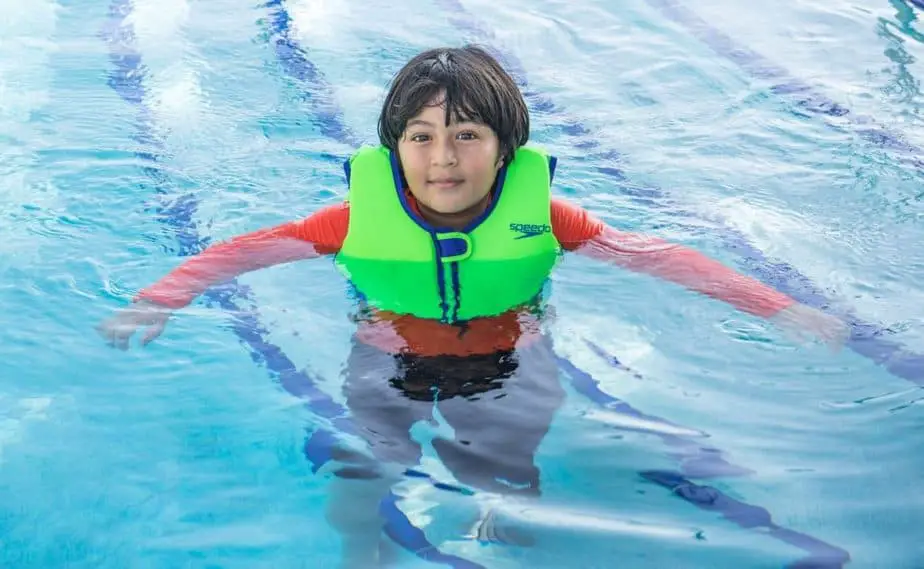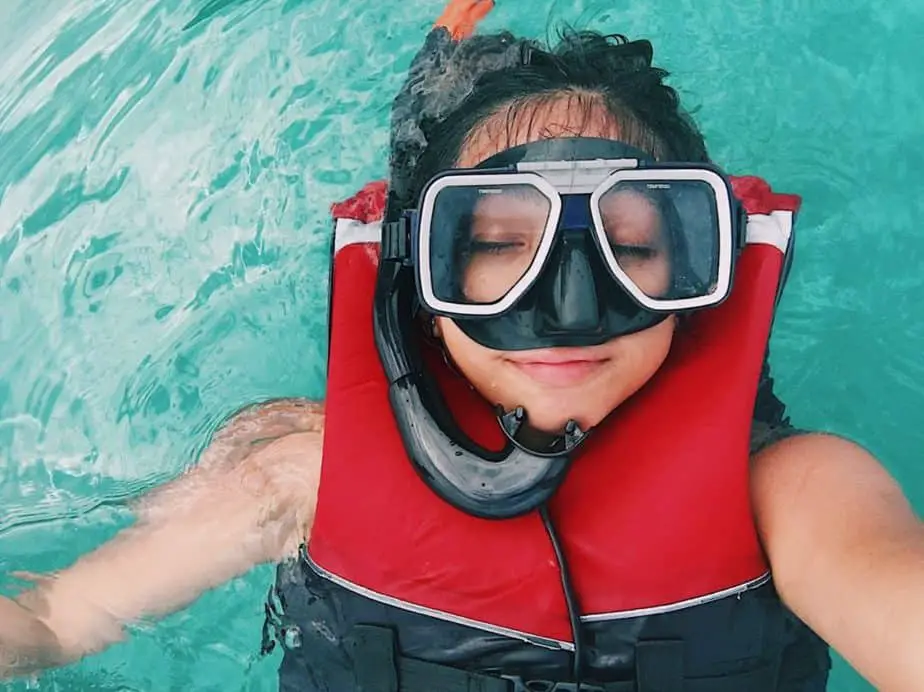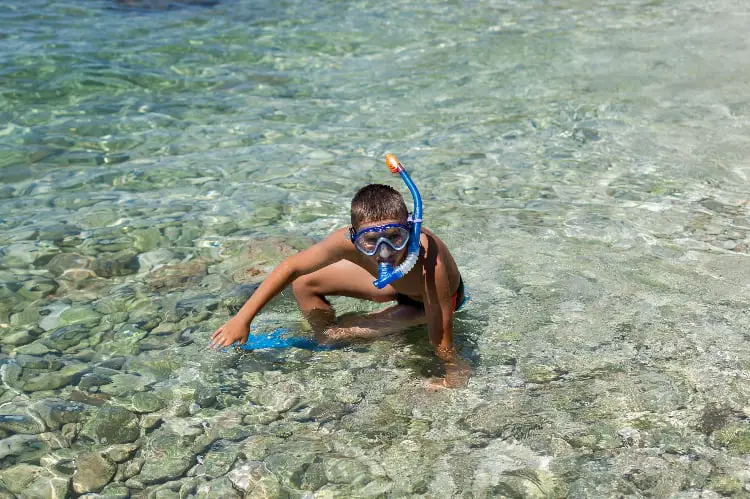If you’ve ever wanted to take your entire family on a vacation to a tropical destination where you can enjoy the ocean and the sun, then snorkeling can be a new activity the whole family can partake in during these vacations. You get to experience sights that you couldn’t find on land, such as sea turtles, brightly colored fish, coral, and lots more! However, there are some legitimate concerns regarding potential dangers in the water, especially for young children.
Many parents with young children who want to take the whole family snorkeling are often left wondering if there is a minimum age for snorkeling. While there is no snorkeling minimum age, it seems parents have taken children as young as two years old snorkeling with them. The most important thing to keep in mind is that they are comfortable in the water and that you are always keeping a close eye on them.
Don’t expect to do much snorkeling of your own, because your eyes need to be glued onto your kids every second. To ensure things go well, we have prepared a guide on how to teach your children to snorkel. Learn about how to find the right mask, snorkel, fins, using a personal flotation device and some basic swimming tips for your kids.
Teach Your Children to Start Snorkeling Early
Kids can learn new things very quickly if they have a great role model to learn from. Therefore, you should be very comfortable snorkeling yourself so that you can educate your children on the proper techniques and safety tips. You can check out our article on how to snorkel if you need a refresher or are a beginner.
Once your children are at the age where being in water feels as comfortable to them as being on dry land, then it is a good time to introduce them to basic snorkeling equipment. Let them play around with a snorkel and mask in the pool, bathtub, or even shallow water by the beach. The goal is to let them get used to wearing snorkeling equipment so that they don’t feel like it’s a nuisance. That way, they will be able to utilize them properly in the ocean when the time comes.
Mask
There are a few things you will need to do to help your children get the perfect mask. First, since they are so small, you will have to purchase either kid’s snorkel masks or snorkel masks for small faces. Getting the right fit is important. Next, you should clean the lenses before letting your children use it. There is a layer of film leftover from the manufacturing process that should be taken care of so that it doesn’t cause the mask to fog up while snorkeling.
The mask is a crucial piece of snorkeling equipment, and the first piece that kids should learn how to wear. It can be tough to teach children not to breathe through their nose, since that is probably what they are used to. Hopefully the prospect of being able to see underwater will help them take their mind off things.
They are probably used to goggles already, but a snorkel mask will need to be used in conjunction with a snorkel, which is why they need to get rid of the habit of breathing from their nose. Furthermore, the nosepiece of a snorkel mask is meant to equalize the pressure, not to let them breathe from their nose.
Getting the Perfect Fit
The tough part of introducing a snorkel mask to extremely young children is that it can be hard to get a properly fitting one. Kids may not be able to withstand any discomfort. If the mask pulls on their hair, squeezes too tightly causing discomfort, or fits too loosely resulting in water leaks, then it can be very frustrating for them. Here are some ways to ensure the mask fits comfortably well on a child:
- Get a mask with a silicone skirt. The skirt is the part of the mask that seals against the face, preventing water leaks. Cheap masks are likely to use plastic skirts which are not as comfortable and don’t seal as well. Consider paying a bit more for a mask with a silicone skirt for a much more comfortable and tight seal on the face.
- Brush the hair back. Before a mask can seal tightly on the face, there must not be anything in the way of the skirt. Hair is the most common culprit in a leaky mask. Children don’t have to worry about facial hair getting in the way, but even just a strand of long hair can cause a leak. Hair creates an opening for air to escape and water to enter. Also, the mask can pull on their hair if it is not fitted along the hairline comfortably. Consider purchasing a swim cap to protect your son or daughter’s hair from any tugging.
- Don’t tighten the straps too much: We’re going to follow the Goldilocks principle here. The mask should not fit too loose nor too tight, which is a common mistake children make. If the mask doesn’t fit your child’s face in the first place, no amount of tightening will make it seal better. A sign of a well-fitting mask is that it should be capable of staying on your child’s face with only some light pressure and without a strap. When you factor a strap into the equation, it only needs to be tightened enough to keep the mask from falling off the face. Any more than that and it can cause discomfort around the eye sockets or nose.
Unfortunately, the process of fitting a mask may involve some trial and error. If your kids start getting frustrated, just try again some other time. Being too pushy can cause them to harbor resentment towards the mask and snorkeling. Next time, either try putting it on at a different angle or use a new mask entirely.
Using the Mask
Once you’ve helped them get a snug fitting mask, it’s time to put it to the test. Encourage your children to look for toys or items in shallow water. Let them get accustomed to the feeling of wearing the mask and thoroughly testing if it leaks, fogs up, or feels uncomfortable. Let your kids practice floating with their body up and their face looking down into the water.
Advanced
Parents with children that are slightly older can teach them some advanced techniques, such as how to clear their mask. For young children, that means standing in shallow water and slightly loosening the mask to allow water to flow out.
For older children, that means showing them how to do that while treading water, or even clearing the mask while underwater by exhaling through the noise. When you’re on a snorkeling trip, keep some defogging solution on hand. Kids are likely to get annoyed when dealing with a foggy mask.

Snorkel
The next piece of equipment you should introduce your children to is the snorkel. You can buy snorkels individually, but sometimes a snorkel mask includes a snorkel. With a snorkel, you must teach your children to breathe with their mouth and not with their nose. This can be slightly distressing since they are so used to breathing from their nose, so get them accustomed to this as early as possible.
Fit
Just like the mask, the snorkel should have the right fit as well. One common mistake parents make is buying a snorkel intended for adults. It will be very long and have a wider bore, which is an issue because a young child’s lung capacity is much lower than an adult’s.
They will feel like they are struggling to get enough oxygen and may be breathing stale air that is not being expelled from the snorkel. Depending on your child’s age and size, you should buy one that you feel is proportionate to what they can handle.
Using the Snorkel
Finally, it is time for them to try out the snorkel with the mask. There are various stages that your children can test the snorkel, each step progressively harder than the last. First, start them off on dry land with the snorkel in their mouth. Show them how to breathe using the snorkel.
Second, let them stand in shallow water where their feet can touch the bottom. Show them how to breathe with the snorkel while their face is submerged to ensure they are getting sufficient oxygen and are getting used to the idea of breathing from their mouth while in the water.
The final step is to let them use the snorkel while they are swimming. Once they reach this point, they basically are already snorkeling! Let them experience each stage until they are comfortable before moving on. They may not like to attach the snorkel to the mask, in which case let them hold onto the snorkel with their hands until they are comfortable. You can help them refine their technique later.
Advanced
Kids probably don’t need to clear water from their snorkel unless waves are crashing overhead or they intend on doing some diving. If so, they should learn to purge their snorkel. The simplest way for them starting out is to lift and dump. Just remove the mouthpiece and dump out any residual water. Let them practice this in shallow water.
The correct way of purging water from a snorkel is by using the purge valve on the bottom. This can be done both out of the water or in it. Get your kids to try it out while standing. You can make a game out of it by encouraging your kids to spray you or each other by forcefully purging the water. If they aren’t capable of the purge technique, that’s fine, the lift and dump method works too.
Fins
While many snorkelers prefer wearing fins, it can be a different story with kids. If they are against it, don’t pressure them to wear them. The most important snorkeling equipment are the mask and snorkel.
Older children will love the extra power they get when kicking with a nice set of fins. They may also like the extra buoyancy that a fin provides, helping them to stay afloat. It won’t be long until they discover how much easier swimming and snorkeling is with the help of fins. The biggest issue is learning how to wear them.
To start, kids should sit on the stairs of a shallow pool or shallow water to put them on. Then cross one foot over the knee of the opposite leg. This gives them easy access to their foot, which they can then easily put the fin on one foot at a time. Next, teach your kids that once the fin is on, they should walk backwards into the water. It is very easy to trip over the long fin blades when walking forward, so start close to the water and walk backwards.
Using the Fins
Once the fins are on, it’s time to practice some kicks. Have your children lay on their back and practice the flutter kick – alternating kicks one at a time. The power should come from their hips and not their knees. Floating on their back gets them used to keeping their body horizontal without a snorkel. Next, flip them onto their front with the snorkel, mask, and fins while practicing kicks and finally your kids are snorkeling!

Snorkeling Child Safety Tips for the Open Ocean
Finally, your kids are ready to try the real thing. They grow up so fast, don’t they? Of course, you’ll still be around to keep close supervision on them and remind them of the techniques you taught. Once you’re at a real snorkeling destination, it’s time to get started. Get your kids to test out all of their snorkeling gear in the hotel pool to check that the gear is working fine.
Next, we recommend snorkeling to a snorkeling location that has little to no waves such as a lagoon or protected bay. This will help them get their first taste of ocean snorkeling with significantly less risks. They will still be able to see the real underwater creatures without worrying about strong currents.
Wear A Flotation Device
Your children should be using a flotation device, such as a life vest, snorkel vest, flotation belt, or pool noodle. If they are really young, then they should only use a life jacket as that is the safest option. Even in shallow water, a kick-board or pool noodle can help them conserve energy and enjoy the underwater sights without worrying about staying afloat. Furthermore, you never know when a sudden riptide might come, so use a flotation device as a precaution.
Pay Attention
Teach your children to be aware of their surroundings, not just for their safety but for the safety of others. No one wants to be kicked in the face or collide into each other. Furthermore, being more mindful can help your children avoid coral since they are actively surveying their surroundings. Having greater awareness can also help them find more underwater creatures to look at without scaring them off, or realize that the waves are picking up and to return to shore.
Keep Close
The younger your children are, the more physical contact you should have with them. Hold their hands or grab onto their life vest, and always stay close to the shore. Again, even in shallow water, the occasional strong current can sweep them away. Furthermore, you will be there to protect and calm your child down if they panic, get injured, or get frightened.
Is There A Minimum Age for Snorkeling – The Verdict
There is no minimum age for snorkeling, and you can take your children with you at a young age.
Additionally, showing your children how to snorkel should be a fun and exciting experience, especially for them. It is a great way to bond with them and create unforgettable memories. Your children will follow your lead. As long as you’re having the time of your life, so will they. And while there is no minimum snorkeling age, what’s important is that you take the necessary precautions to ensure that your kids are equipped and trained to be in the water.
By introducing this wonderful hobby to them at a young age, they have a lot of time to improve their skills and it gives the whole family a reason to take a nice vacation to incredible snorkeling destinations like Hawaii, Thailand, or Mexico. As your children get older, they can get more autonomy in the water and soon you won’t have to worry about them at all anymore. And all of this can happen at a relatively young age if you’re willing to show them the ropes.
You may also be interested in reading about the minimum age for scuba diving, which is a bit more strict compared to snorkeling.


